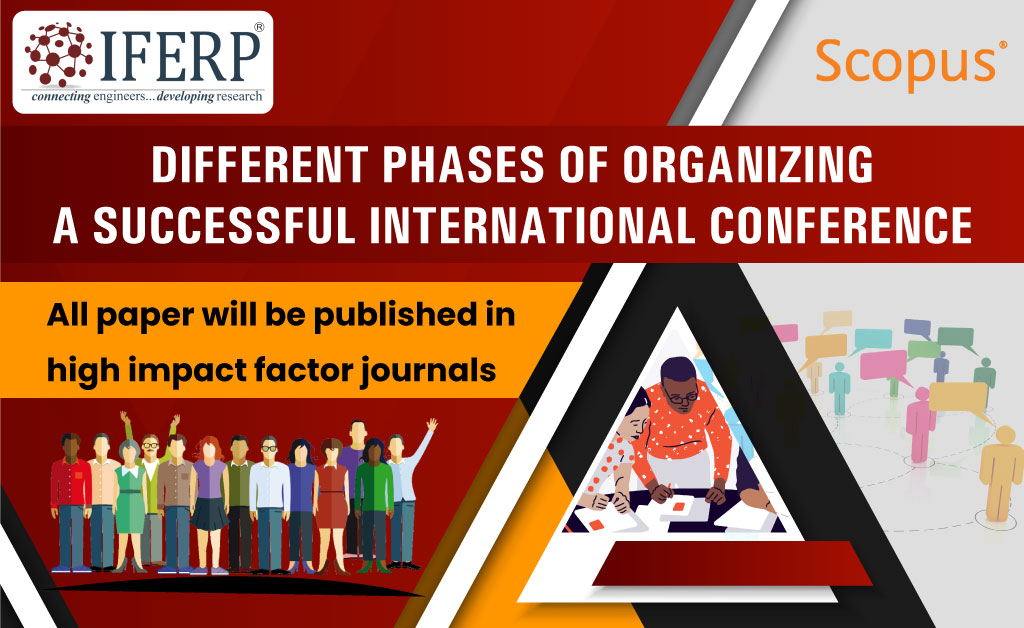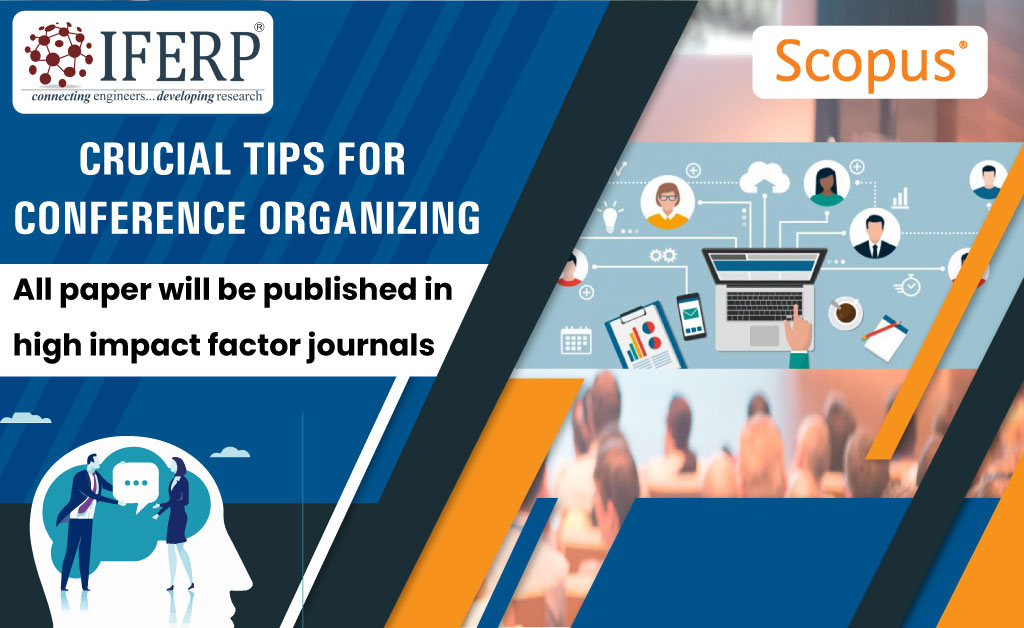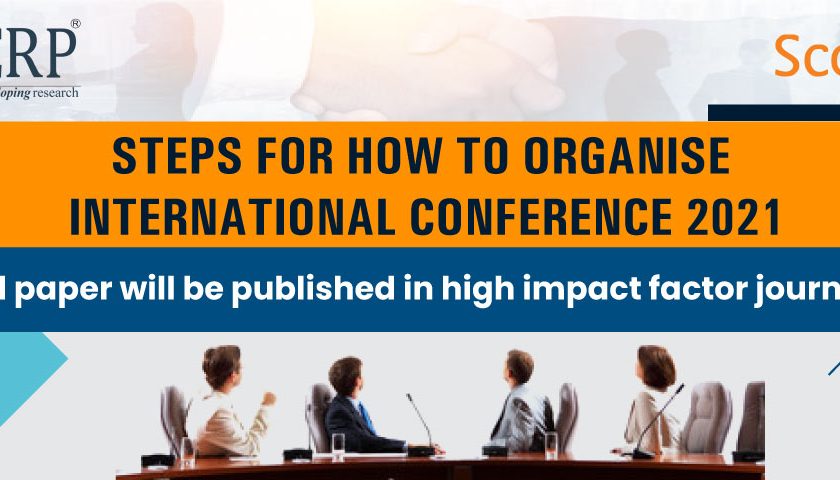With engineering and technology conference organizing, as with so many other things, paying attention to the minutiae of the event is imperative. Organizing a successful international conference is mostly about getting the following things right –
- publicizing the event,
- getting people to sign up,
- choose the right location,
- communicating with the people who manage the space, and so on.
There are obvious differences between having a small local conference, which is attended mainly by people who are already known and have established contact with and having an international conference that attracts hundreds (if not thousands) of professionals from all over the globe, most of whom don’t know the organizers or one another. However, there are also general guidelines that work for both.
It must be said here that a conference, even a small one, requires a lot of work. Organizers need to start, as explained below, months or even a year or more in advance (for a large conference) to ensure that sufficient space has been arranged for and everything else is in place by the time they need it. For this reason, the first decision they need to make is whether they really want to host a conference. Essential questions that they need to ask themselves are –
- Do we have the necessary financial, personal, and other resources required to organize a successful conference?
- Do we have the time and the energy to do it?
- Are there others (either individuals or organizations) who’d be willing to take care of the organizing (either in part or in entirety)?
- Are there better ways to achieve the objectives that have been set for this conference?
If the answers to all of these questions point to hosting a high-level 2023 international conference, then it is best to go for it. If the answers to these questions point to uncertainty, it is important to think carefully about whether this is worth the time and money or not. Once the decision to move forward has been made, one way to keep all of the details under control is to make lists of everything that has to be done. Having a checklist of necessary tasks for each of the jobs that need to be done right from setting up to identifying and inviting presenters, etc., helps combat forgetfulness (not to mention stress), helping increase efficiency.
Organizers have to remember that the more work they can delegate to others (who are capable enough) to handle, the better. This is because the coordinators and the committee members have too much work to do than just to spend their time discussing menus or the number of chairs needed. Sub-committees, individual sub-coordinators, or volunteers can take on these tasks and do them well. It is also important not to exhaust anyone – the conference will be much more successful if the organizers find most of the work enjoyable and doable.
Different Phases Of Organizing A Successful International Conference
- Creating An Organizational Structure
Organizers need to start off by bringing together the group of people who are going to organize and run the conference and plan how they will work together.

- Planning The Conference
Organizers need to promote the conference as well as recruit and register participants.
- Running The Conference
Organizers need to carry out an assessment of the conference and implement the conference organization process.
Crucial Tips For Conference Organizing
- Ensuring The Venue Is Perfect For The Event Being Planned
Alternative venues can add an unexpected touch to a conference. Places such as museums, historic sites, theaters, libraries, and sports stadiums have all hosted conferences. However, considering the needs of the participants, a venue should set the stage for the conference to do its job, not steal the show. Ensuring the spaces are of a comfortable size for the large group seminars or breakout sessions that the participants will need, that there are adequate restrooms for the size of the event, that the catering meets the needs of special dietary requirements and that the location is ADA compliant, are all crucial.

Hotels and conference centers are specially designed to meet these needs and allow people to focus on the content of the proceedings, so organizers shouldn’t overlook these traditional venues. Conferences that draw attendees from out of town are particularly well served by the convenience of hotel accommodations, group rates, and the best networking opportunities to have everyone in one place.
- Paving The Path For Smooth Networking Right Before The Conference Begins
Networking is one of the biggest reasons professionals participate in international conferences. Face-to-face networking also happens to be many times more effective than online networking. These events allow people to talk and connect with those who share their professional interests or personal passions, which facilitates their success.
Those conference organizers who are either already using or are in the process of developing a conferencing application should think about ways the application itself can support networking –
- Before The Commencement Of The Conference Organizers should allow attendees to import their LinkedIn profiles instead of having to create an event-specific profile, letting people mark their interests and specialties and interact with other participants interested in the same topics or attending the same sessions.
- While The Conference Is Underway
The application should provide in-app messaging, making it easier to connect with participants in the same sessions/social events or follow up with participants who have posted on the social wall.
- Subsequent To The Conclusion Of The Event
The application should provide access to the contact information so that participants can easily maintain the connections they have made.
Organizers should make sure they provide sufficient old-fashioned offline opportunities as well. Designing opportunities that also include introverts in networking is a great way to witness increased event satisfaction amongst at least fifty percent of all participants of an event.
- Coming Up With A Comprehensive Content Agenda That Offers Unique, Never Before Known Takeaways
If attendees are coming to the conference to learn more, following a clear plan to research the content is recommended. First, if possible, organizers should ask their audience about the topics, subtopics, and depth of knowledge in the topic. It may seem like a trap if organizers are attracting an audience with their content. When it comes to surveying an audience, there are two possibilities – in the case of a recurring event, contacting previous attendees is recommended; setting up an event Facebook group, which offers simple polling functionality, also helps. And if all else fails, interviewing a selection of people who are likely to come or whose career/interest demographics place them squarely in the target audience also works.
If surveying is not an option, speaking with stakeholders in the field helps in acquiring invaluable insight. Business development and marketing teams need to be up to date on the topics and trends that are currently generating the most interest.
With this information in hand, recruiting and confirming the right speakers becomes easier. Once the main speakers are confirmed, it is important to check the original plan against the lineup. If any topics are missing, reaching out to experts in that niche field and filling in the gaps is important.
- Devising A Conference Marketing Agenda
The conference website forms the core of the marketing agenda because it’s easy to spot, it supports the entire event and helps participants find everything they need. The event website should be optimized for search engines so that people find it online. Thinking about what attendees might look for in an upcoming educational conference in 2023 related to their interests or sub-discipline in engineering and technology helps in this regard as these will help in realizing what the main keywords that should be targeted are. As it gains traction, the conference name itself will be a keyword. Including the conference name and other keywords on web page titles and throughout the content is also imperative. Having a logical structure that makes it easy for visitors to find the “About” page, conference schedule, and registration information is crucial, along with providing a “Registration” page and other vital conference info.
Social media platforms, email marketing campaigns, and PPC (pay-per-click) advertising all form integral parts of a conference marketing agenda. Reaching the target audience on the social platforms (by acquiring an understanding of their demographics) as well as relevant technology journals and scientific publications helps in making these endeavors more fruitful and effective. While LinkedIn can be employed to attract established professionals, Twitter can be used to draw the attention of early-career professionals, students, and younger audiences.
- Being Aware Of The Most Common Conference Organizing Mistakes & Avoiding Them At All Costs
Roadblocks are bound to come up, there’s no getting around it. But watching out for the common hurdles detailed below and being aware of them helps in avoiding them.
- Making The Cancellation Policy As Clear As Possible For Participants
The policy itself can be whatever the organizers decide upon – either an out-and-out “No refund” “Refund up to two weeks in advance”, “Full refund anytime”, or even one year after the event. Whatever it is, it is crucial to make sure it’s clear and highly understandable.
- Leaving Sufficient Time To Reach Out To Speakers
The truth is, not everyone is as punctual or responsive to emails as others. Obtaining all the necessary information from multiple speakers can be an ordeal that requires repeated outreach, so creating a buffer for it is crucial.
- Training & Equipping Event Registration Staff Sufficiently
Long lines and constant problems with registration give attendees a first impression that isn’t positive in any way. Choosing an easy-to-use event registration tool (even in the case of an 2023 online virtual conference) and scheduling a time for the registration staff to familiarize themselves with before the day of the event helps tremendously in this regard.
- Taking All Necessary Safety & Precautionary Measures
The days when safety was an afterthought are long gone. Getting the initial inputs of safety advisors early in the planning process helps in seamlessly integrating them early on, instead of having to rearrange the event later just to accommodate these measures.
- Establishing Clear Lines Of Communication
There’s no reason to face confusion over layout versions or endless searches for the right discussion thread these days. Using project collaboration tools, like Slack or Trello, and offering team members access to the event layout tool helps facilitate better collaboration between members of the event organizing committee.
- Taking The Perspective Of The Participant Throughout The Planning & Organizing Processes
Coming up with a conference planning calendar and plan a metaphorical presentation of the conference several times from the perspective of not just participants but also,
- speakers,
- volunteers,
- exhibitors, and
- sponsors,
- helps in the organizing of a user-driven event.
This helps in looking for pain points and problems, as well as ways to improve each group’s experience. By doing so, organizers may find, for instance, that participants in some sessions don’t have a lot of time to use the bathroom between sessions on the first day, so they will have to set aside a few minutes each session to solve this problem, or perhaps the volunteers who arrive on the second day do not have a coordinator to carry out their tasks, or maybe there is sufficient time to plan a short networking meeting for the event speakers, which can prove to be a great way to show them appreciation. Whatever the experience, this step almost always reveals opportunities to improve the conference.
- Increasing App Engagement
According to the IFERP, increasing participant engagement remains the number one priority for conference organizers. The more involved participants are in the application, the greater the benefits. A conferencing application offers all the benefits of traditional paper-based conference information while achieving three essential goals –
- understand the wants, needs, and interests of participants,
- establishing a strong connection with participants,
- offering sufficient opportunities for participants to have their work published in a renowned Scopus journal of their choice, and
- helping participants connect with each other.
To increase engagement even before the conference begins, encouraging attendees to use the app to plan their schedule by including an easy-to-use calendar feature that makes all necessary information easily accessible is crucial. This also helps in giving people a way to find detailed agenda information, speaker biographies, as well as in submitting questions to speakers.
Once the conference has started, participants should be familiar with using the application. Keeping them engaged with content like speaker slides and networking opportunities helps in this regard. Organizers could even feature the option to complete in-app speaker reviews at the end of each session, with respondents being entered for a draw directly at the conference.
Conferences come in many forms, but they all need to be organized. While conferences, small and large, local and large-scale, have different needs, there are organizational guidelines that work for the most part. Just about any type of conference needs a framework of people and systems to build on. Any conference must be planned – its location, space, time, content, and form must be determined. Any conference must inform its target audience of its existence and convince that audience – or enough of them – to attend. Any conference must attract interesting speakers, whether they come from the office next door down the hall or from all over the world. Any conference should be well run so that the participants have a good experience. And one conference should also be monitored and evaluated so that the next one is better.
Whether it’s an immediate issue, improved practice, networking, or advocacy, a conference should excite attendees and leave them wanting more, whether it’s more ideas, more contact with other participants who share the same concerns, more change, more ways of doing their jobs easier or otherwise. A good conference has the capacity to set in motion currents which can have a great influence on an issue or an area. It pays to organize an event well.


